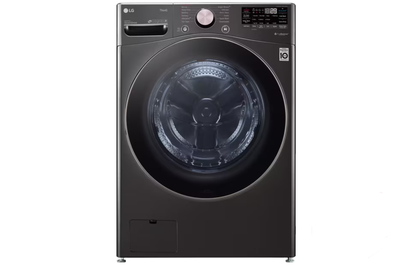I Didn’t Know My Washing Machine Had a Brain. Then It Told Me I Was Doing My Laundry Wrong.

By Jon Chase
Jon Chase is an editor of smart-home coverage. For Wirecutter, he learned how to pick smart locks and shaved a colleague’s head to test hair clippers.
In the classic hierarchy of human needs—you know, food, shelter, safety, broadband internet—a washing machine with smart features doesn’t rate.
When I bought my LG WM3600HWA, a precursor to the LG WM4000H, our current pick, I didn’t even notice it had smart features. (At the risk of self-incrimination, I’m a smart-home editor.) After all, why would you want a washing machine with brains? If anything, it only increases the risk of them rising up to overthrow the human race.
But one slow day, I succumbed to curiosity. And whaddya know, it’s pretty cool.
Our pick
This speedy and gentle front-loader makes easy work of laundry, and its modestly higher IQ provides convenience and peace of mind.
Buying Options
Costco Membership required, price reflects in cart
This washing machine has a useful app (really)
After taking a few minutes to download the LG ThinQ app and connect the washer to my Wi-Fi, I began getting notifications whenever my laundry was done. As smart capabilities go, it’s no great shakes, but it’s useful, and a far nicer mechanism than the typical beeps, buzzes, or whimsical ditties that have become a common and bizarre addition to many appliances these days.
The delights kept on coming. One day I got a notification that a load of towels was particularly out of balance and should be adjusted to avoid damaging my machine. Pretty cool! After a month, an email appeared with usage statistics (how many cycles we’d used, what modes we favored) and—get this—a series of diagnostics confirming that the water supply, drain, and all the various internal mechanicals were all in fine working order. This blew my mind: I can’t be bothered to get a physical on the reg, and now I’ve got a washer with its own Mayo Clinic built in.
I will not claim that the smart capabilities of this washer are truly Life-Changing. But for anyone who has endured the exasperation of a prematurely dead consumer durable (I’m looking at you, accursed Samsung dishwasher)—or nursed a limping machine for far too long without a diagnosis or cure—an appliance that is smart enough to tell you when something is wrong, and how to fix it, is at the very least game-changing.
It’s a smart device that isn’t needy
The nicest thing about LG’s ThinQ system is that, unlike with many smart devices, all the techie stuff lives contentedly and quietly in the background. No need to concern yourself with deciphering jargon or poking around an app (unless you want to). You can ignore it without fear or guilt. And when something does go pear-shaped, you’ll get what you need. For instance, along with receiving the alert that my machine’s load was dangerously unbalanced, I got a link to more info on why it likely happened (I overfilled the tub) and how to prevent it going forward.

LG’s ThinQ-enabled washers routinely check to ensure that the flow of water in and out is normal and that the drum is spinning correctly. (While my companion dryer has modest smart features, they weren’t a factor when I chose to buy it. We recommend the LG DLEX4000 dryer because it performed well in our tests, drying a king-size comforter and an 8-pound set of sheets with ease.) A company representative explained that these machines detect errors using two methods: Smart Diagnosis, a built-in system for checking on sensors and mechanical functions, and ThinQ Care, which uses machine-learning artificial intelligence to analyze and detect problems over time.
So you may get an AI-generated notification that something needs to be addressed—like the example of my machine being unbalanced—that isn’t strictly a mechanical problem. But if your washer endures an actual mechanical failure, your machine has the ability to periodically check all its functions and send an alert if something is malfunctioning.
A built-in check-up system
If something seems amiss and the washer doesn’t flag it, you can request a full sensor diagnosis in the app. The process is unexpected and cool (a brief but satisfying exercise for anyone with a bent for gadgets): Open the LG app, select Audible Diagnosis, and hold your phone up to the machine and hold a button on the washer’s display. Your washer will emit a signal that sounds like what the offspring of a fax machine (Google it) and R2-D2 (Google it) would produce. A few seconds later, the results are in. (I’ve found you can do this at least six times in a row and it’s still fun). Since then, I’ve also received alerts that I need to run the clean cycle, and that I’ve put in too many items at once.

This ability to confirm everything is in working order provides legit peace of mind—imagine a world where all our devices could tell us when they aren’t feeling well—and the app is a rarity in that it provides a path to a human being for customer support. The Care tab at the bottom of the app dashboard takes you to a page where you can swipe to “concierge service,” LG’s aspirational term for a customer support line reachable by phone. Representatives can work with you in real time to diagnose any problems and hopefully resolve them.
The last time I tried to have an out-of-warranty appliance repaired, the total projected cost far eclipsed the price of a new washer. Near-instant remote access to company experts would’ve been handy.
Its smarts are more C student than genius (and that’s just fine)
The ThinQ app enables a few other capabilities, though their value is probably limited to superfans.
For instance, you can opt to start your laundry remotely, a capability I found puzzling until another editor noted it would be helpful to start a load that would finish just before arriving home, so you don’t have wet clothes moldering all day (some editors are brighter than others). You can also use ThinQ Rewards, a program which purportedly rewards gift cards in exchange for your engagement, a curious arrangement for the act of doing one’s own laundry (aren’t clean clothes reward enough?).
More usefully, you can download presets or customized wash-cycle settings and access them by turning the settings dial on the machine to “Downloaded.” But you can only add one preset at a time, and since the machine’s display doesn’t have a label for it, you could easily forget what you’ve downloaded (heaven forfend if you accidentally run your unmentionables through a denim cycle).
It’s possible to link your washer or dryer with other LG devices in the app so they’re all in one interface, and then use preset or custom Smart Routines so the devices trigger automatically. (One included preset is Goodbye Dust, which tells LG air conditioners and air purifiers to turn on when air quality drops below a threshold.) But generally speaking, third-party apps like Alexa and Apple Home do the same thing and work better. LG would do well to stay in its lane and let the other companies handle the heavy smart-home lifting.
This article was edited by Ingrid Skjong and Catherine Kast.
Further reading
Meet your guide
Jon Chase is an editor leading smart-home coverage at Wirecutter. He has been covering technology as a writer and editor since the days before mobile phones got smart. His work has been featured in various print and online publications, and on television. He currently has over 35 smart devices installed in his home. None of them work perfectly.


